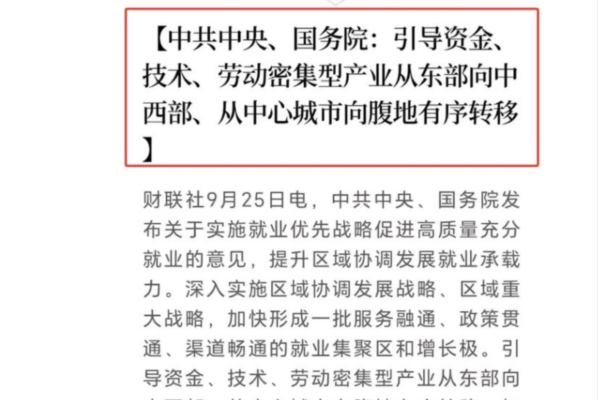In recent days, there has been a viral rumor circulating on the mainland Chinese internet that 1,500 factories in Guangdong are planning to relocate to Sichuan. Some scholars believe that this rumor is not without basis. Certain expressions in documents from senior Chinese Communist Party officials have sparked more attention, making it a hot topic of discussion among the public.
On various social media platforms in mainland China, the news of 1,500 enterprises in Guangdong planning to move to the southwestern region of Sichuan has attracted attention and sparked discussions among netizens.
A post by the public account “Wood Heart” stated: “Recently, a piece of news has garnered wide attention: 1,500 factories from Guangdong will move to Sichuan. This move is like a giant stone cast into a calm lake, causing ripples one after another.”
According to a report by Caixin on September 25, the Chinese Communist authorities will guide enterprises to shift from the eastern regions to the central and western regions. Sichuan has been singled out as the only strategic hinterland in the high-level approval of national territorial spatial planning.
The article from the public account “Wood Heart” mentioned that companies such as TCL Group, Lenovo Group, Xiaomi Technology, Gree Electric Appliances, Changhong Electronics, Haier, Huawei, and others totaling 1,500 enterprises will embark on this large-scale migration.
So far, mainland Chinese media has not reported on this hot topic, nor have they publicly denied it.
The rumor of the “great migration” of 1,500 enterprises from Guangdong is reminiscent of the Chinese Communist Party’s “Third Front Construction” in the 1960s and 1970s. During that time, the Party moved a large number of industrial and military facilities to remote regions in the central and western parts of China.
According to Radio Free Asia, scholar Kuang Jinli, who is familiar with the “Third Front Construction,” stated in an interview on the 16th that in the 1960s and 1970s, the migration of factories from coastal areas like Shanghai and Guangzhou inland was to assist the manufacturing industry in the southwest and northwest regions. However, now “the situation has changed, the times have changed, there is no front or rear. They have always been worried that if an attack occurs, coastal cities and important processing and technological forces are hit, it would be fatal.”
Kuang Jinli, who participated in the Third Front Construction in Sichuan, said that the so-called grand Third Front established in Sichuan in the last century has been mostly abandoned: “The original grand Third Front has basically been abandoned, the factories in the mountain gullies of Sichuan are still there, some turned into night markets, some abandoned and deserted. Reviving the Third Front is a waste of human and financial resources, utterly unnecessary.”
Reports mention that scholar Tian Qiguang, who has studied the Third Front Construction, said in an interview that initially, he thought the news of Guangdong enterprises migrating to the southwest was false, but later found that the State Council of China indeed had such thoughts. He believes that this kind of thinking is historically known as “wartime thinking,” similar to the Third Front Construction that followed the Zhenbao Island Incident in 1969.
Facing the current situation, Tian Qiguang believes that the authorities are adopting a wartime thinking mode, which will have a negative impact on the economic enterprises in Guangdong and the employment of the people.
Tian Qiguang criticizes this wartime thinking, pointing out that the related actions exacerbate international tensions, even carry a threatening nature, and may ultimately end up as a “failed project.”
The Beijing News reported on October 13 that on September 25, the Central Committee and the State Council of the Chinese Communist Party issued a document proposing policies to promote high-quality and full employment. However, the expression “guiding the orderly transfer of capital, technology, and labor-intensive industries from the east to the central and western regions, from central cities to the hinterland” in the document has drawn more attention. The economic factors, social demands, and national strategies behind industrial relocation have become the focus of heated discussions.
Previously, Xinhua News Agency also reported that the Central Committee and the State Council of the Chinese Communist Party issued the “Opinions on Implementing the Strategy of Prioritizing Employment and Promoting High-Quality and Full Employment,” specifically mentioning guiding the transfer of capital, technology, and labor-intensive industries from the east to the central and western regions.

